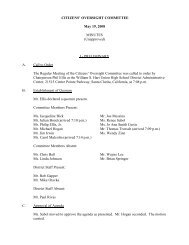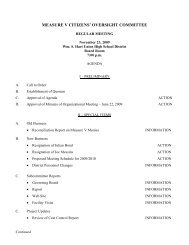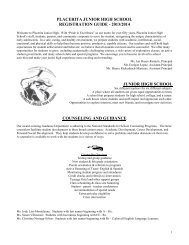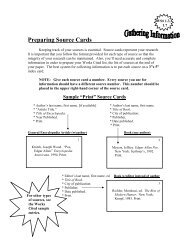Safe School Plan - William S. Hart Union High School District
Safe School Plan - William S. Hart Union High School District
Safe School Plan - William S. Hart Union High School District
Create successful ePaper yourself
Turn your PDF publications into a flip-book with our unique Google optimized e-Paper software.
INCIDENT: THUNDERSTORM 5<br />
(For Home and Work)<br />
Thunderstorms are very common and affect great numbers of people each year. Despite their small size in comparison to hurricanes and winter<br />
storms, all thunderstorms are dangerous. Every thunderstorm produces lightning. Other associated dangers of thunderstorms include<br />
tornadoes, strong winds, hail, and flash flooding. Flash flooding is responsible for more fatalities— more than 140 annually— than any other<br />
thunderstorm-associated hazard.<br />
Some thunderstorms do not produce rain that reaches the ground. These are generically referred to as dry thunderstorms and are most prevalent<br />
in the western United States. Known to spawn wildfires, these storms occur when there is a large layer of dry air between the base of the cloud<br />
and the ground. The falling raindrops evaporate, but lightning can still reach the ground.<br />
What to do before thunderstorms approach<br />
1. Know the terms used by weather forecasters:<br />
Severe Thunderstorm Watch— Tells you when and where severe thunderstorms are likely to occur. Watch the sky and stay tuned to<br />
radio or television to know when warnings are issued.<br />
Severe Thunderstorm Warning— Issued when severe weather has been reported by spotters or indicated by radar. Warnings indicate<br />
imminent danger to life and property to those in the path of the storm.<br />
2. Know thunderstorm facts:<br />
Thunderstorms may occur singly, in clusters, or in lines.<br />
Some of the most severe weather occurs when a single thunderstorm affects one location for an extended time.<br />
Thunderstorms typically produce heavy rain for a brief period, anywhere from 30 minutes to an hour.<br />
Warm, humid conditions are very favorable for thunderstorm development.<br />
A typical thunderstorm is 15 miles in diameter and lasts an average of 30 minutes.<br />
Of the estimated 100,000 thunderstorms each year in the United States, about 10 percent are classified as severe.<br />
A thunderstorm is classified as severe if it produces hail at least three-quarters of an inch in diameter, has winds of 58 miles per hour<br />
or higher, or produces a tornado.<br />
3. Know the calculation to determine how close you are to a thunderstorm:<br />
Count the number of seconds between a flash of lightning and the next clap of thunder. Divide this number by 5 to determine the<br />
distance to the lightning in miles.<br />
4. Remove dead or rotting trees and branches that could fall and cause injury or damage during a severe thunderstorm.<br />
5. When a thunderstorm approaches, secure outdoor objects that could blow away or cause damage. Shutter windows, if possible, and<br />
secure outside doors. If shutters are not available, close window blinds, shades, or curtains.<br />
5 Are You Ready? A Guide to Citizen Preparedness, FEMA 2002<br />
85

















